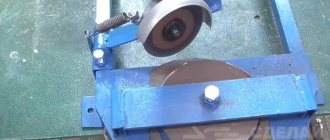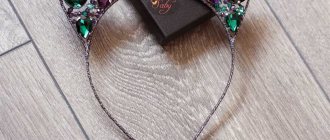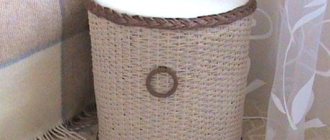As you know, males show interest in any type of weapon at any age. And if you don’t know what to give as an original gift to a man or what craft to make for your son for school, then we advise you to look at swords.
Today we will tell you how to make a paper katana with your own hands in a matter of minutes. This is a very simple but interesting model that even a child can make. There are two most common manufacturing methods, which we will consider in more detail today.
Manufacturing process
So, let's look at how to make a katana out of paper. The first thing you need to do is prepare five rectangles for the blade. It is better to cut them from durable cardboard. Determine the length yourself, but the width in this craft is fixed - six centimeters. In order for you to get a fairly strong blade, you should evenly and carefully lay the strips of cardboard one on top of the other. We will fix the workpieces with PVA glue. Then we place some weight on top and leave the blade to dry for two to three hours.
For the handle of the sword we use a tube of foil or baking paper. It should be thoroughly painted with silver paint. Let the paint dry.
We prepare the guard. This is a circle that protects the hand from contact with the blade. The guard can be cut from cardboard or made from plain paper. If you make from paper, you will need about ten layers, which are carefully coated with glue. How to make a katana sword out of paper to make it more realistic? Try carefully cutting out a beautiful design on the guard. It is better to do this with a sharp stationery knife. If the craft is done by a child, then it is recommended to seek the help of parents in this matter.
Now all that remains is to connect the pieces. We insert a blade into the hole in the tube and place a guard between them. If the need arises, we adjust the dimensions and angles using stationery scissors.
So, we told you how to make a katana out of paper. The scheme is simple and clear. Now all that remains is to use your imagination and paint the product with acrylic paints.
Necessary materials
- Scissors.
- Paper.
That's all the materials that will be needed for such a craft. We decide on the size. The A4 format will allow you to make a small sword, but if you take A3 or A2, you will get a rather impressive and formidable weapon.
This option will be performed using the classical technique - origami. The katana will not be a craft made from several pieces, but one sheet folded in a certain way.
The first thing you need to do is fold the sheet diagonally and cut off the excess to make an even square. We bend the corners on both sides so that they meet in the center. Now we unfold the sheet and make folds on the long side. Next, without turning the sheet over, roll up the short sides of the square. You should end up with a long rectangle with curved corners.
Now we form the handle. To do this, you need to bend one corner and lay it three-quarters the length of the entire rectangle. Now we fold it again, but the length will be even shorter. When you unfold and turn the product over, in this place it should look like an accordion made of paper.
We mentally divide the strip into three parts and wrap the two outer parts towards the center. Now we bend the part where the accordion was to the side. It turns out to be a handle. All that remains is to add a sharp angle to the sword where the piercing pike will be.
We told you only about two ways to make a katana out of paper. But there are many more of them. If your product turns out to be too fragile, then you can always strengthen it with tape. Several layers - and the origami craft will be strong and reliable.
The production of a katana is divided into a large number of stages and can take several months. First, Tamahagane steel pieces are placed next to each other, covered with a clay solution and covered with ash. This allows you to remove slag from the steel, which during melting will be removed from the metal and will be absorbed by clay and
ash. Next, the metal pieces are heated to combine them. After this, hammer forging occurs: the created rod is flattened and folded, then flattened again and folded again - thus doubling the number of layers (with 10 folds, 1024 layers are obtained, with 20 - 1048576) As a result, the carbon is evenly located in the rod, which allows make sure that the strength of the blade is the same over the entire surface.
Katana manufacturing technology
Then it is necessary to put softer steel into the workpiece so that the blade does not break under severe dynamic loads. During forging, which takes several days, the workpiece is lengthened and by joining strips of different hardnesses, the structure of the blade and its original shape are formed. Next, a series of liquid clay is applied to prevent oxidation and overheating. A pattern is formed on the cutting edge - the jamon hardening line.
This line becomes visible when polishing the sword. Hamon is a distinctive sign of the master; by it it is possible to find out who created the katana. Then the sword is hardened: it heats up to a temperature of approximately 840-850 ° C and immediately cools, as a result of which the katana takes on extraordinary hardness. In addition, during the hardening process, the blade bends on its own, while the magnitude and shape of the deflection are specific and depend on the cooling method. Then the blade is given a finished look, sharpened and polished using stones of different grain sizes. Moreover, the master strives to achieve completely flat surfaces and clear angles of edges between planes. Sometimes on parts of the katana that have not been hardened, decorative engraving is created, usually on the theme of Buddhism. After polishing and decorating the handle, the katana can be used.
We present our developments in videos of fencing with katanas, machetes and knives. After watching our films, you may discover some new aspects of history, weapons, and culture. This section presents fencing techniques, the technique of their implementation, and the technique of movement during execution. Knife fighting videos on techniques and techniques will delight anyone who is seriously involved in knife fighting. We pay a lot of attention to technique, all our lessons are designed so that you can watch not just the quick execution of techniques, but understand how this technique is performed. For this reason, the show is often performed in a slightly slower format, which of course does not negate its fast execution during production. Separately, there are sparrings - videos of knife fights. Here you can see the real application of the techniques shown earlier in other videos.
Standing apart are small feature films related to weapons, the history of samurai, the making of samurai swords, traditions, old photographs and much more. We sincerely hope you enjoy these films.
Another aspect of our knife fight videos is testing strikes and weapons on real flesh - on pieces of meat - on pork knuckles, pork side. This is necessary to understand HOW a blow is delivered with one or another weapon, what passes and what does not, and often commonly used myths are dispelled during such testing. We don't want to be like Discovery or Cold Steel, not at all, but we like their format and we adopted it for ourselves.
We sincerely hope our videos of knife fighting, techniques with a katana and machete will not disappoint you and you will find something useful for yourself in them.
Do-it-yourself katana sharpening
Sharpening a katana with your own hands is not nearly as difficult as it might seem.
In ancient times in Japan there were special craftsmen who spent weeks sharpening on water stones. There have always been very few such masters and their services were incredibly expensive. Not only was the cutting edge itself processed, but the blade itself was polished - all this was part of the understanding of sharpening a katana. Today, sharpening refers to processing only the cutting edge of the blade and bringing it to a razor-sharp state.
Contrary to popular belief, this is quite easy to do today at home with your own hands. The standard cost of a one-time blade sharpening is from 1,500 rubles. But what can you do yourself at home - how to sharpen a blade so as not to spoil it? Well, first of all, you need to understand why you are sharpening your katana. For chopping makivar from rice straws is one thing, for chopping not too thick tree trunks is another thing, for chopping all sorts of meat items such as sausages is something else.
Let's do real sharpening of a katana at home with our own hands.
The weapon used was a Chinese katana, hardness up to 52 - 54 units, monosteel, spring, nothing unusual, a fairly cheap sample. For sharpening we took musat, a fiskars type sharpening device with rotating stones, and a bottle of oil.
First, all small roughness and burrs are removed from a completely working blade, which has just been used to chop a lot of plastic bottles using musat. Then, using a Fiskars type sharpening device, the knurling edge of the katana is sharpened.
The result is checked on a piece of paper. As a rule, one pass is not enough for normal paper cutting and razor sharpness, and therefore the blade is lubricated with oil and rolled back into sharpening devices. Taking your time, a katana blade can be sharpened in three to five steps.
As you can see from the video, a sharpened katana cuts paper like a razor.
Evgenia Smirnova
To send light into the depths of the human heart - this is the purpose of the artist
Content
This question is asked by many parents of mischievous boys. All the kids play various role-playing games or imitate their favorite ninja characters from cartoon series. There are many toys, swords, and laser weapons on store shelves, but it is much nicer for a son to receive a gift that mom or dad made with their own hands.
Video
So we made with our own hands, in ordinary home conditions, a semblance of a samurai sword made of wood. After it is made, it is advisable to impregnate it with wood resin or varnish. The video provides instructions for making this product; after watching it, even a beginner can make a bokken.
Article genre - Japanese weapons
Buy original Japanese-themed clothing and accessories in our store. Stand out among the gray mass by buying a T-shirt, hoodie, and pants with the image of a samurai!
Source
How to make a katana out of paper - diagrams with photos
This process is not at all difficult, the main thing is to start. With step-by-step instructions, everyone will figure out how to make a katana out of paper. Involve your child so that he doesn’t get bored at this time, or prepare a pleasant surprise for him in the evening. You can make a Japanese sword with your own hands from plain paper, cardboard, or use the origami technique.
DIY paper katana using origami technique
If you are wondering how to make an origami sword out of paper, follow the instructions:
- Take half of a regular landscape sheet. It is advisable to use colored paper in light shades.
- Prepare similar parts of the sheets, but in a dark color - this will be the handle and sheath of the katana. Apply the resulting blade to one, mark the length of the future handle and separate the dark-colored sheet.
- Make a sheath out of most of it. Bend the edge that will be located at the tip inward, the opposite, on the contrary, outward.
- Wrap the blade in a dark sheet and secure the sheath with glue.
- The remaining small leaf is the handle. Insert its edges into the slit of the blade and wrap it around. In order to practically understand how to make a sword out of paper and please your child, it’s time to glue the two halves of the finished Japanese sword.
How to make a sword from cardboard
To prepare a pleasant surprise for your son or husband, you need to know how to make a katana out of paper. To do this you will need:
- cardboard (you can use regular boxes);
- PVA glue);
- knife (stationery);
- glue (carpentry);
- paint of different colors - silver, black, red, blue.
If you still have no idea how to make a sword out of cardboard, know that it should be at least 60 cm in length. This should be used as a starting point when calculating the size of parts. Toy weapons, just like in Japan, are easy to make:
- From cardboard you need to cut five rectangles 50-70 millimeters wide. In this case, take into account how the wavy stripes are located on the material. On two of them they should be located vertically, on three – horizontally. Next, you need to stack them on top of each other, starting with those with stripes in the vertical direction.
- Glue the pieces together. For a stronger connection, you should place the workpiece under a heavy object (then the sword will become dense, like a wooden block).
- When the workpiece dries, you need to draw a drawing in the shape of a weapon and cut it out of cardboard.
- Apply glue (carpenter's glue) to the sidewalls where the corrugation is visible. It is better to pour it in two layers, then let it dry for about 10-12 hours.
- The last stage before the paper katana is ready is painting. We cover the blade with silver paint, make the handle black, and paint the invented design on it with the remaining colors.
- If desired, coat the blade with clay and sand before painting - then the sword will be even denser.
DIY samurai weapon made of paper - Deadpool's katana
Before you make a paper sword, you need to prepare:
- cardboard;
- compass;
- marker (black);
- paper tubes (two thick, two thinner);
- scissors;
- braid.
The easiest way to make a katana out of paper:
- We make 3 circles on the cardboard, one equal to the diameter of the smallest tube, the second equal to the diameter of the other. The last circle will be 1-1.5 cm larger than the second. Trim off the excess cardboard and cut out a small circle using a utility knife.
- We flatten the smaller tubes, get two rectangular plates, and fasten them with tape. This will be the blade. We perform similar actions with large tubes that will serve as sheaths.
- We make the tip of the blade: we draw what it will be, cut it off, and seal it with tape.
- We insert two tubes inside the blade, adding volume.
- To make the katana look like steel, wrap the blade in foil several times and secure it with office glue or tape.
- We make a handle: we fix the main tube on which it will be held with glue. We color the plate that will serve as a tsuba with a black marker. We wrap the tube-handle with tape and secure the edges with tape. We put on the tsuba, then the handle.
- We paint over the entire surface of the scabbard with a bright black marker.
They have survived to this day and do not lose popularity. Since ancient times, the katana has been made from damask steel - “Anosov” steel, but fighting with such a tool is dangerous, so we’ll put the original samurai weapon aside for now, let it decorate the interior.
If you decide to study the ancient art of the samurai, then a bokken, a wooden analogue of a blade, is perfect as a training weapon. “How to make a katana from wood?” - Many people asked themselves this question, but only a small number of samurai mastered the wooden bokken technique.
Making a samurai sword from wood video
So we made with our own hands, in ordinary home conditions, a semblance of a samurai sword made of wood. After it is made, it is advisable to impregnate it with wood resin or varnish. The video provides instructions for making this product; after watching it, even a beginner can make a bokken.
Article genre - Japanese weapons
Hello dear kenshi
!
Today I would like to tell you how to make your own handle ( tsuka
) for katana (
iaito, shinken
).
I was prompted to prepare this review by the need to restore my old iaito
, which, for a number of reasons, was missing a handle. Making a handle to order in Russia or Japan is quite expensive and takes a lot of time and resources. So I decided to save time and money, plus check the place where the hands grow.











